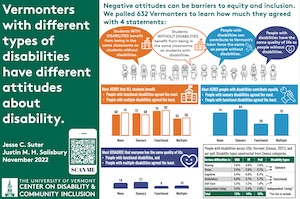The Vermonter Poll
- Each year, the UVM Center for Rural Studies sends out a statewide poll for Vermonters. It's called The Vermonter Poll.
- This year, CDCI, Vermont Developmental Disabilities Council, Disability Rights Vermont, and the Disability Law Project worked together on adding questions about disability to the Vermonter Poll. This was the first time The Vermonter Poll included questions about disability.
We polled 632 Vermonters to learn how much they agreed with four statements:
- People with disabilities have the same quality of life as people without disabilities.
- People with disabilities can contribute to Vermont’s labor force the same as people without disabilities.
- Students with disabilities benefit from being in the same classrooms as students without disabilities.
- Students without disabilities benefit from being in the same classrooms as students with disabilities.
Only Vermont residents over the age of 18 could participate.
Results
Most Vermonters who completed the survey agreed:
People with disabilities have a LOWER quality of life
When students with and without disabilities are in class together ALL students benefit
People with disabilities contribute EQUALLY to the labor force.
But we also found that Vermonters with different types of disabilities have different attitudes about disability.







